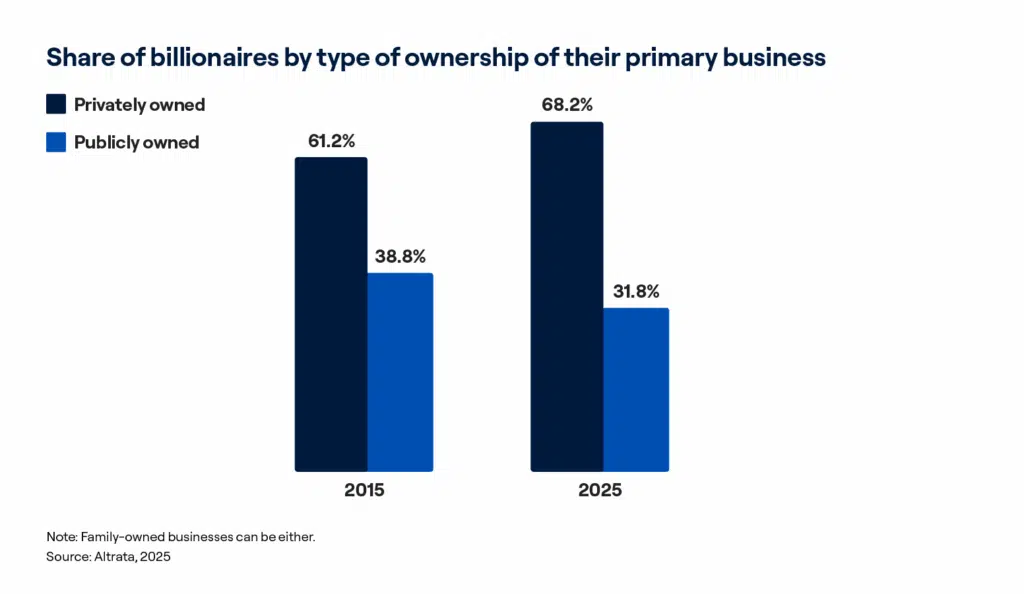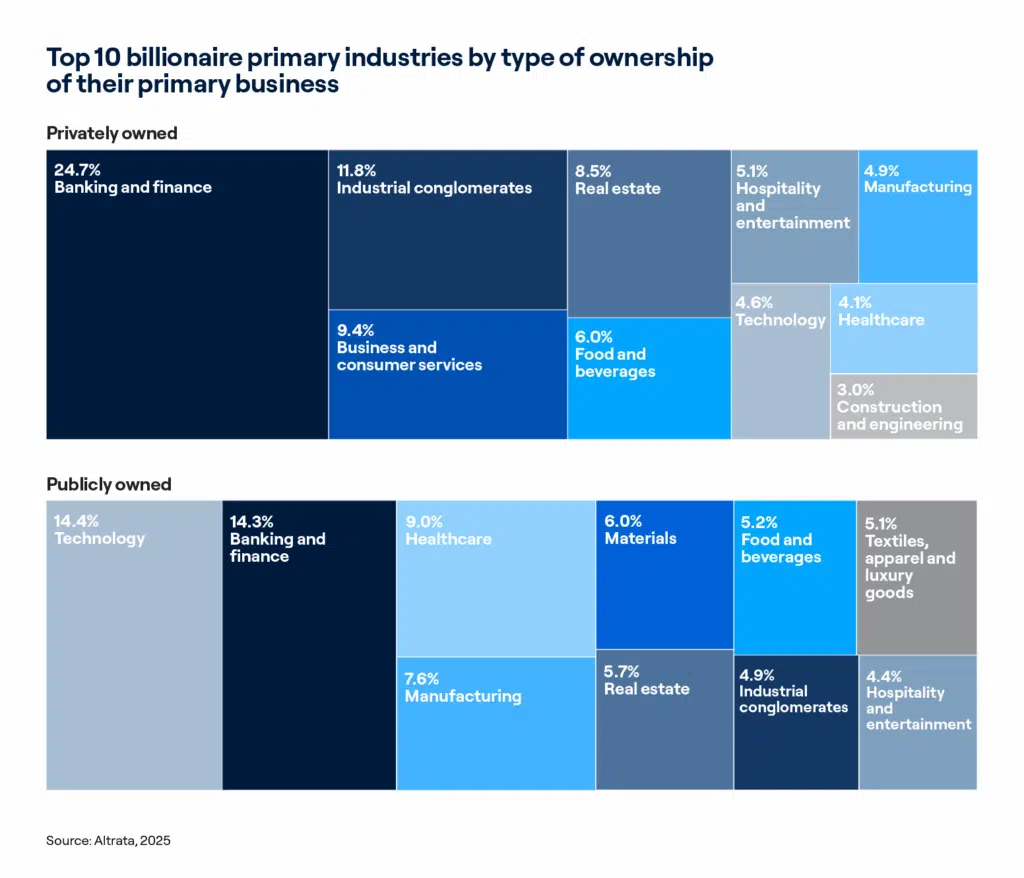The vast majority of billionaires are the outright owners of very large businesses (or they are in possession of significant shares in them). Yet whether these businesses are privately owned or publicly traded is a different consideration altogether, and this difference in ownership matters.
Following on from our annual Billionaire Census 2025, here we focus on today’s billionaires by public holdings versus private ownership. Using Altrata’s extensive database of the global wealthy, we reveal the extent to which billionaires’ primary businesses are privately owned or publicly traded, and the standout differences by wealth tier and industry sector. Such insights are vital for a true understanding of this highly impactful demographic.
Type of ownership of primary business
Two-thirds of billionaires’ primary businesses are owned privately – a share that has risen over the past decade
Some 68% of the primary businesses of the global billionaire population are in private ownership, double the share of publicly traded companies. Numerous factors can influence an individual’s choice of whether to retain key commercial interests as private holdings or seek a public listing. These include their personal wealth status, the existing ownership structure of the business (whether founders, family, individual or group), the degree of access to private capital and liquidity, the strategic goals for the business, their attitudes towards regulatory oversight and public scrutiny, their preferred level of control over the business, and the private-public mix of their overall wealth portfolio.

The share of billionaires’ primary businesses that are private holdings has increased by seven percentage points over the past decade from just over 60% in 2015. This mainly reflects the greater share of newly created companies over this period that have remained in private hands, but it is also the case that certain billionaires have opted to take publicly owned businesses back under private control. The global market for initial public offerings (IPOs) has slowed significantly since 2021 in response to volatile geopolitics, heightened uncertainty over government policies, more stringent (and costly) public market regulation, and the greater availability of private capital in the form of private equity, venture capital and an emerging channel of private credit funds.
Private or public by wealth tier
The share of publicly traded primary businesses is highest among billionaires in the top $5bn+ tier.
Wealth among billionaires is not divided equally. Just over half of the world’s richest individuals are in the ‘lowest’ billionaire wealth bracket, each with a net worth of between $1bn and $2bn. A further third of billionaires each have a net worth of $2bn to $5bn. Bracketed together, this grouping of 83% of the global billionaire population holds a combined 38% of total billionaire wealth. A mere 17% have more than $5bn but command 62% of all billionaire wealth.

When it comes to their primary businesses, the share of privately owned primary businesses among billionaires with a net worth of $1bn to $5bn is on a par with the global average, at around 70%, with little difference across the two lower wealth tiers. There is a higher representation of publicly traded companies among the more exclusive group of billionaires with fortunes of $5bn+, with two in five primary businesses listed on the stock market.
In recent years, equity returns in most leading wealth markets have been volatile but strong overall, which has significantly bolstered the valuations of certain publicly owned companies. As previously noted, the gains have tended to be heavily concentrated in large cap stocks in certain sectors, notably technology and communications.
Private or public by industry focus
The technology sector accounts for the highest share of billionaire’s publicly traded companies.
With most of the billionaire class preferring to keep their main commercial interests under private control, the ranking by industry focus of all privately owned primary businesses exhibits a similar pattern to that of the overall billionaire population. A quarter are financial services companies, double the share of second-ranked industrial conglomerates. Around one in 10 primary businesses in private hands operate in the business and consumer services sector, with real estate the next most common industry.

There is a markedly different industry focus among the smaller grouping of billionaires’ primary businesses that are publicly traded on the stock market. Technology firms top the ranking, with a share three times greater than among private companies. Given the nature of the global technology boom, the dynamic growth potential of tech firms will tend to attract stronger investor interest than companies in other sectors. Going public can therefore provide rapid access to larger amounts of capital at more favorable valuations than might be available via private markets, while also raising the profile of a business. In such a competitive field, this can be crucial in providing the funds for aggressive expansion and infrastructure development. Stock options are also deployed widely in the tech sector as a means to attract and retain employee talent.
Financial services companies rank a close second among publicly listed firms in a nod to the sector’s dominant representation among the global billionaire population. The need to meet often stringent capital requirements and regulatory disclosures also make public markets a more natural fit. The next-ranked industries of healthcare, manufacturing and materials (comprising the mining, paper and chemicals sub-sectors) all feature more prominently than among the group of privately owned companies. This is influenced by factors such as high capital intensity, the regulatory landscape, the prospect of high potential returns in breakthrough products or discoveries and, in some cases, lengthy development timelines that may deter private funding pools with a more short-termist outlook.
For more insight into the billionaire population and the latest trends, access our Billionaire Census 2025 report.
About the authors

Maya Imberg is the Head of Thought Leadership and Analytics at Altrata. She is responsible for spearheading the company’s thought leadership efforts and overseeing its analytics and predictive modeling services commissioned by clients. She joined Altrata’s Wealth-X in 2016 as Director of Custom Research responsible for secondary research, data analytics and branded content.
Maya has over fifteen years of experience in research, spanning market research, macroeconomics and financial services. Prior to joining Wealth-X, Maya held a variety of consultant and economist roles at the Economist Intelligence Unit and spent a number of years working for Datamonitor’s Financial Services practice. Maya holds an undergraduate and MSc degree in economics and comparative politics from the University of Pennsylvania and London School of Economics respectively.

Maeen Shaban is Director of Research and Analytics at Altrata, where he leads a revenue-generating analytics function delivering bespoke insights on global wealth and influence. With a background in financial engineering and advanced research into sovereign wealth strategies, Maeen brings deep analytical expertise and commercial acumen to the evolving landscape of private wealth.
He plays a central role in shaping Altrata’s global thought leadership program, co-authoring its flagship publications including the World Ultra Wealth Report and the Billionaire Census. His work draws on proprietary datasets, financial modelling, and targeted research to support strategic decision-making across the private wealth, luxury, and philanthropic sectors.
Maeen’s current focus includes wealth transfer trends, the role of single family offices, and the spending priorities of the ultra-wealthy—insights that are increasingly valuable to businesses navigating the expectations and behaviors of today’s most affluent individuals and families.